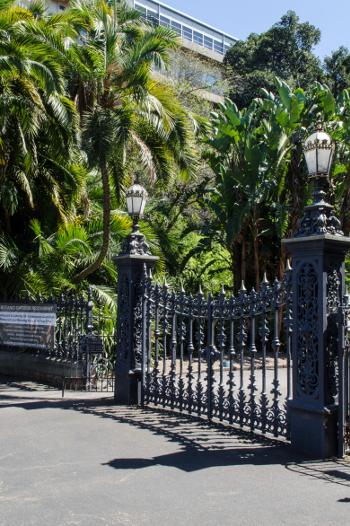Visit the Botanic Gardens
Duration/age

Are you wondering what your family can do this weekend? You could visit the Botanic Gardens.
Before you go to the gardens talk to your child about the different things you can do and see there.
Explain that the garden is divided into different sections and each section tells a story of different types of plants and where they can be found. Explain to your child that the plants are grouped into ones that are the same. Some of the plants will be in special houses because they need hot weather to grow.
We can visit the Bicentennial Conservatory. It's like a giant hothouse for rainforest plants. They need heat and lots of water.
Once you get there what will you do? Will you follow the map around the garden? Is there a special theme you want to search for in the garden?
I have packed a picnic to take with us. When we get to the Botanic gardens we can eat our picnic on the big lawn near the duck pond. We'll need to look at the map to find where we need to go.
I want to look at the gardens with plants that we can grow and eat at home.
As you walk around the gardens talk about the different textures, smells and colours. You could point out the different colours and textures of the leaves or walking paths. How many different scents and fragrances can you smell?
There are lots of different fragrances in the herb and kitchen garden. Some of the leaves smell like lemon or curry when you hold them in your fingers.
Before you leave the garden see if you can find a hill for rolling down or a narrow creek for jumping over.
Materials you will need
- Botanic Gardens
- Botanic Gardens map
Alternative tools
- Botanic Gardens website / app
Skills this activity improves
Why does this matter?
Talking about textures and what you notice helps your child to develop their natural sense of wonder and the language to describe what they see.
Talking together about what you have noticed and felt helps your child to ask questions. As they notice objects they can group them and compare the differences. When they talk about what they notice they are developing language to describe their thinking and observations.
When children begin to describe their thinking they have started to hypothesise. When they hypothesise they are beginning to connect what they see to past experiences and use this information to make decisions and reflect on why things have happened.
What does this lead to?
Talking about and exploring the natural and everyday environment with your child will help them to develop the skills to notice, take risks and ask questions. Even if your child does not have a natural disposition to be creative and curious, by exploring and posing questions you are helping your child to experiment with different ways of thinking.
Language to use
- Collecting, sorting, grouping, noticing
- Same, different
- Leaf, seed, plant, flower, tree, bush, shrub, grass
- Palm House, Waterlily Pavilion, conservatory, arbour, kitchen garden, kiosk, duck pond
- Pond, creek, waterway
- Mediterranean, rainforest, pine forest, palm, rose, international, herb, lowland, habitat
- Entrance, opening hours
- Birds, mini-beasts, critters, spiders, ducks, stick insects, centipedes
- Map, walkway, pathway, road
- Scent, smell, fragrance
- Roll, jump, hop
- Texture, touch, feel, sensation
- Soft, hard, prickly, smooth, sticky, lumpy, slippery
- Colour, shade
Questions to use
- How many different shades of green can we find?
- Do all leaves feel the same?
- Do leaves have a smell?
- Can you roll on a flat surface?
- Can you eat all plants?
Useful tips
- You can find out more about your nearest Botanic Gardens online.
- You might also like to take a look at the activities Collections and What does that feel like?.
- Take some time to explain to your child that not all plants are edible and that some can make you very sick.
- Remember to talk to your child in your home language.
More ideas
- Make your own map to follow.
- Take photos of plants that you might like to grow at home. You can search for them later at your local nursery.
Variation by age
Birth to two year olds
- Make a texture storybook.
- Make a 'feely' bag with different textures inside. Sort and group different objects by colour, shape or texture.
Three to five year olds
- Make a texture storybook.
- Make a 'feely' bag with different textures inside. Sort and group different objects by colour, shape or texture.
- Download and follow the parks app.
- Make your own storybook about your visit to the gardens.
- Make matching cards from the photos you took at the gardens.
- Take colour sample cards with you. How many different shades of green can you find?
Questions to ask
- Can you find a soft leaf?
- Can you find a prickly leaf?
- Which leaf is the same colour as this?
Questions to ask
- Do all leaves feel the same?
- Do all plants flower during the day?
- What do plants eat for food?
- Do all plants need light?
- Why do some plants grow in water?


